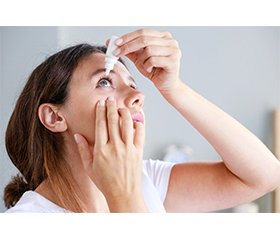Архів офтальмології та щелепно-лицевої хірургії України Том 1, №2, 2024
Вернуться к номеру
Особливості застосування сльозозамінників залежно від форми випуску при лікуванні хвороби сухого ока у пацієнтів з хворобою Паркінсона
Авторы: Гріжимальська К.Ю., Комаровська І.В., Кукуруза Т.Ю.
Вінницький національний медичний університет ім. М.І. Пирогова, м. Вінниця, Україна
Рубрики: Хирургия, Офтальмология
Разделы: Клинические исследования
Версия для печати
Хвороба Паркінсона є другим за поширеністю у світі нейродегенеративним захворюванням у людей похилого віку. Відповідно до статистичних даних кількість людей з хворобою Паркінсона у 2030 році сягне 10 мільйонів. Специфічні симптоми паркінсонізму, зокрема тремтіння, брадикінезія, ригідність м’язів, впливають на якість життя цих пацієнтів та їх можливість виконувати звичні повсякденні маніпуляції. Некроз дофамінергічних нейронів у чорній субстанції головного мозку, яка відповідає за синтез нейромедіатора дофаміну, призводить до зниження його вироблення, спричиняючи зменшення частоти моргань, що є вирішальною для адекватного зволоження поверхні очей. Окрім того, у пацієнтів з хворобою Паркінсона низка біохімічних процесів спричиняє специфічні зміни стану слізної плівки, серед яких, наприклад, зміна структури секрету мейбомієвих залоз, який є зовнішнім шаром слізної плівки, забезпечує утримання сльози на поверхні ока та запобігає випаровуванню її водної складової частини. У лікуванні хвороби сухого ока (ХСО) на сьогодні не завжди вдається досягти успіху навіть у пацієнтів без обтяженого супутньою патологією анамнезу. Найкращі результати у зменшенні проявів ХСО досягаються призначенням сльозозамінників. Однак з огляду на основні прояви хвороби Паркінсона звичне використання сльозозамінників у вигляді очних крапель супроводжується труднощами і потребує сторонньої допомоги. Пошук нових методів лікування ХСО та шляхів введення сльозозамінників є надзвичайно актуальним. Розуміння того, що діагноз «хвороба Паркінсона» необоротний і пацієнти з цією хворобою будуть жити тривало, спонукає лікарів усіх спеціальностей, які мають будь-який стосунок до симптомів, що проявляються у таких пацієнтів, максимально полегшити їхнє життя та зробити старіння якомога комфортнішим.
Parkinson’s disease is the second most common neurodegenerative disease in the elderly in the world. According to statistics, the number of people with Parkinson’s disease in 2030 will reach 10 million. Specific symptoms of parkinsonism such as tremors, bradykinesia, muscle stiffness affect the quality of life of these patients, and the ability to perform everyday manipulations. Necrosis of dopaminergic neurons in the substantia nigra, which is responsible for dopamine synthesis, leads to its reduced production, resulting in a decrease in blinking frequency, which is crucial for adequate moistening of the eye surface. Moreover, in patients with Parkinson’s disease, a number of biochemical processes cause specific changes in the state of the tear film, for example, in the structure of the meibomian gland secretion, which is the outer layer of the tear film, ensures the retention of tears on the eye surface and prevents the evaporation of its water component. Today, the treatment of dry eye disease is not always successful, even in patients without a history of comorbidities. The best results in reducing the manifestations of dry eye disease are achieved by prescribing tear substitutes. But given the main manifestations of Parkinson’s disease, the usual use of tear substitutes in the form of eye drops causes difficulties and requires external assistance. The search for new methods of treating dry eye disease and ways of administering tear substitutes is extremely urgent. The understanding that the diagnosis of Parkinson’s disease is irreversible and that patients with it will live long lives forces doctors of all specialties who have anything to do with the symptoms in such patients to make their lives as easy as possible and to make aging as comfortable as possible.
хвороба Паркінсона; хвороба сухого ока; паркінсонізм; сльозозамісна терапія
Parkinson’s disease; dry eye disease; parkinsonism; therapy with tear substitutes
Для ознакомления с полным содержанием статьи необходимо оформить подписку на журнал.
- Dorsey ER, et al. Global, regional, and national burden of Parkinson’s disease, 1990–2016: a systematic analysis for the Global Burden of Disease Study 2016. The Lancet Neurology.17.11(2018):939-953.
- Marino BLB, et al. Parkinson’s disease: a review from pathophysiology to treatment. Mini reviews in medicinal chemistry. 20.9(2020):754-767.
- Vijiaratnam N, et al. Progress towards therapies for disease modification in Parkinson’s disease. The Lancet Neurology. 20.7(2021):559-572.
- Schapira AHV. Neurobiology and treatment of Parkinson’s disease. Trends in pharmacological sciences. 30.1(2009):41-47.
- 11 квітня — Всесвітній день боротьби з хворобою Паркінсона. https://phc.org.ua/news/11-kvitnya-vsesvitniy-den-borotbi-z-khvoroboyu-parkinsona.
- Biousse V, et al. Ophthalmologic features of Parkinson’s disease. Neurology. 62.2(2004):177-180.
- Weil RS, et al. Visual dysfunction in Parkinson’s disease. Brain. 139.11(2016):2827-2843.
- Archibald NK, et al. The retina in Parkinson’s disease. Brain. 132.5(2009):1128-1145.
- Ekker MS, et al. Ocular and visual disorders in Parkinson’s disease: common but frequently overlooked. Parkinsonism & related disorders. 40(2017):1-10.
- Visser Femke, et al. Diplopia in Parkinson’s disease: visual illusion or oculomotor impairment? Journal of neurology. 266(2019):2457-2464.
- Nowacka B, et al. Ophthalmological features of Parkinson disease. Medical science monitor: international medical journal of experimental and clinical research. 20(2014):2243.
- Craig JP, et al. TFOS DEWS II definition and classification report. The ocular surface. 15.3(2017):276-283.
- Ungureanu L, et al. Dry eye in Parkinson’s disease: a narrative review. Frontiers in Neurology. 14(2023):1236366.
- Blinchevsky S, et al. Meibum lipid composition and conformation in parkinsonism. EC ophthalmology. 12.4(2021):20.
- Vázquez-Vélez GE, Huda YZ. Parkinson’s disease genetics and pathophysiology. Annual review of neuroscience. 44(2021):87-108.
- Міністерство охорони здоров’я України, Асоціація офтальмологів та оптометристів України. Синдром сухого ока: клінічна настанова, заснована на доказах. 2019.
- Demirci S, et al. Evaluation of corneal parameters in patients with Parkinson’s disease. Neurological Sciences. 37(2016):1247-1252.
- Ulusoy EK, Döndü MU. Evaluation of corneal sublayers thickness and corneal parameters in patients with Parkinson’s disease. International Journal of Neuroscience. 131.10(2021):939-945.
- Söğütlü Sarı Esin, et al. Tear osmolarity, break-up time and Schirmer’s scores in Parkinson’s Disease. 45.4(2015):142-145.
- Bayer AU, et al. Association of glaucoma with neurodegenerative diseases with apoptotic cell death: Alzheimer’s disease and Parkinson’s disease. American journal of ophthalmology. 133.1(2002):135-137.
- Ben-Shlomo Y, et al. The epidemiology of Parkinson’s disease. The Lancet. 403.10423(2024):283-292.

